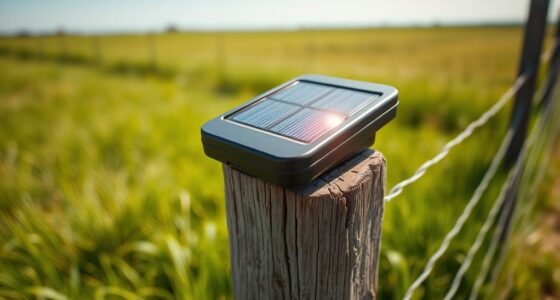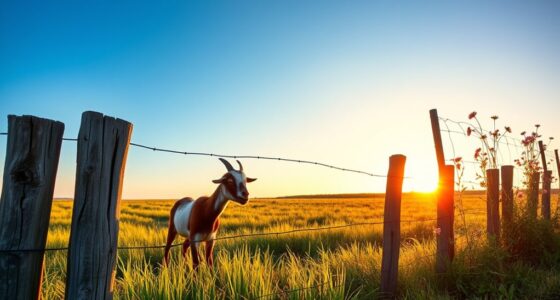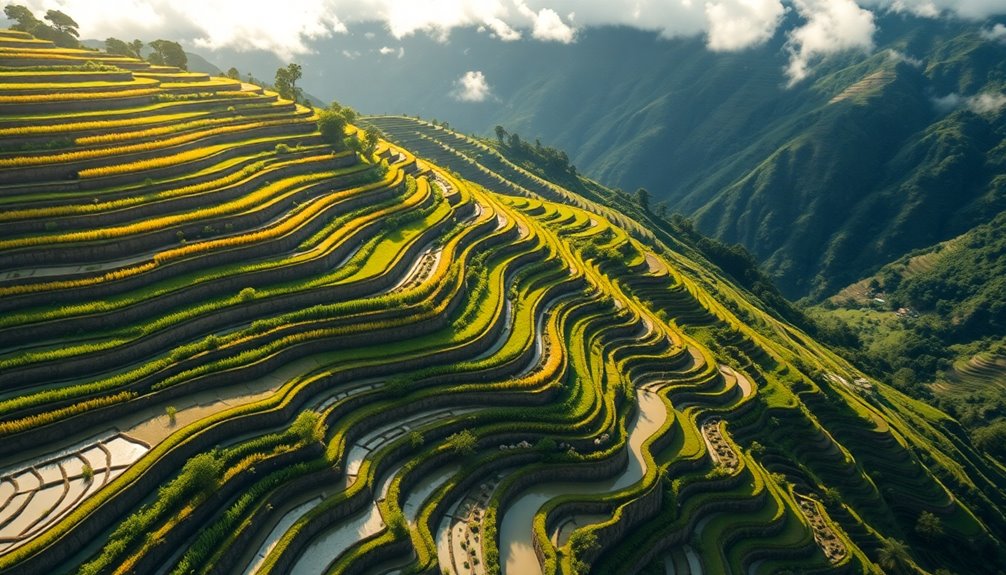Plant planting for pollinators supports bees and boosts biodiversity by choosing native plants that bloom throughout the year, providing continuous nectar and pollen. Creating diverse habitats with layered plantings, shelter, and water sources encourages healthy bee populations. Avoid pesticides and chemical fertilizers to keep pollinators safe. By designing your garden thoughtfully, you help sustain local ecosystems and attract a variety of pollinators. Keep exploring ways to improve your garden’s impact for more tips and ideas.
Key Takeaways
- Plant a variety of native species that bloom at different times to provide continuous nectar and pollen sources for pollinators.
- Incorporate layered plantings, including ground covers, shrubs, and trees, to offer shelter, nesting sites, and habitat diversity.
- Avoid synthetic pesticides and fertilizers; use organic methods to promote healthy pollinator populations and biodiversity.
- Create dedicated habitats like bee hotels, bare ground patches, and water sources to support nesting and hydration needs.
- Engage the community through planting workshops, education, and habitat monitoring to sustain pollinator health and ecosystem resilience.
Understanding the Importance of Pollinators in Ecosystems
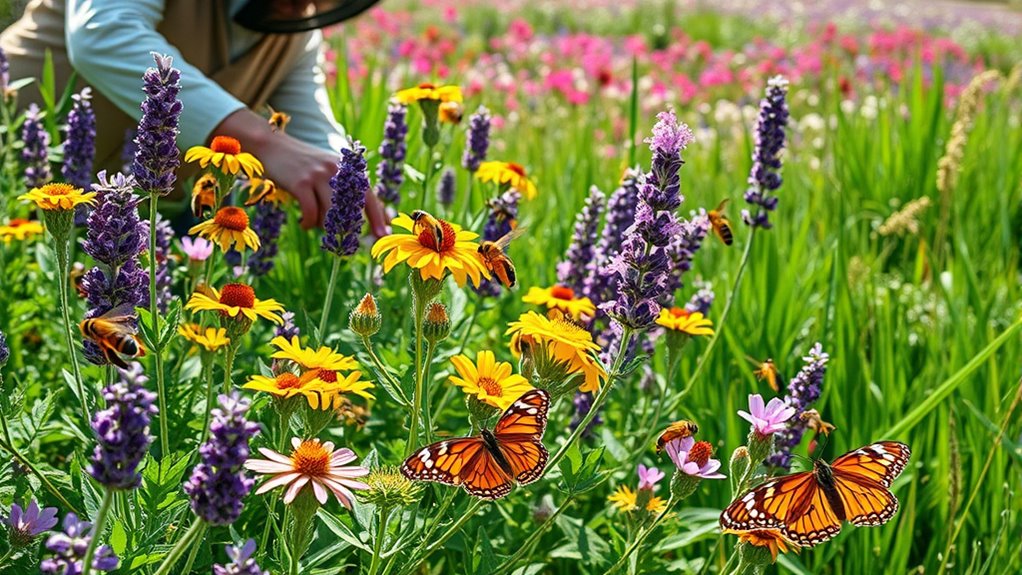
Pollinators play a crucial role in maintaining healthy ecosystems by enabling plants to reproduce and thrive. When you support pollinators, you’re helping guarantee the production of fruits, seeds, and vegetation that form the foundation of food chains. These creatures, including bees, butterflies, and hummingbirds, transfer pollen from one flower to another, facilitating fertilization. Without them, many plant species would struggle to reproduce, leading to a decline in biodiversity. This decline affects other wildlife that depends on plants for shelter and sustenance. Additionally, healthy pollinator populations help stabilize ecosystems by promoting plant diversity and resilience. By understanding their importance, you can better appreciate how essential they are for natural balance and how your gardening choices can support their survival. Implementing habitat creation and reducing pesticide use are effective ways to help sustain pollinator populations.
Choosing the Right Plants for Pollinator Gardens
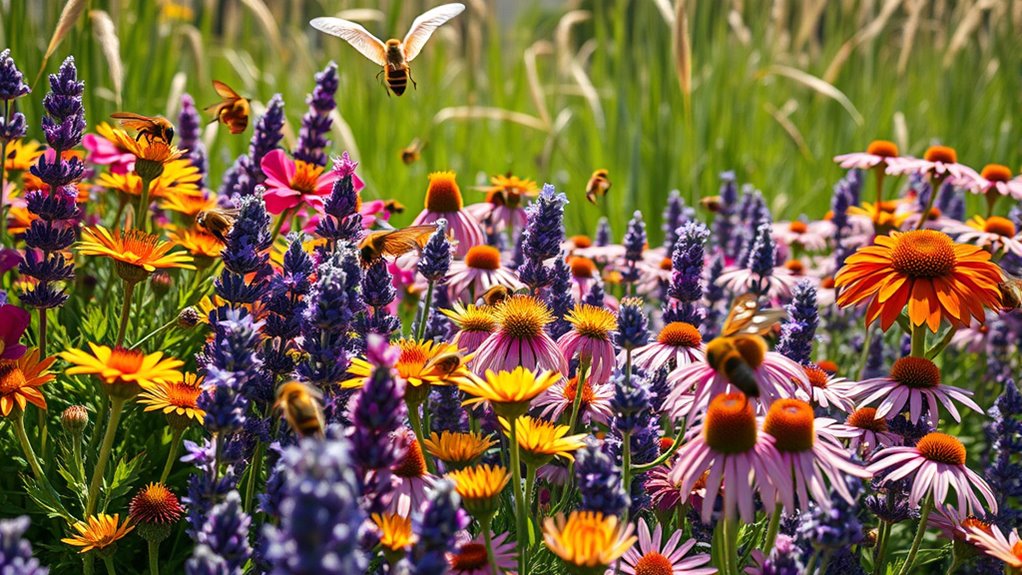
Choosing the right plants is essential for creating a thriving pollinator garden. Focus on native plants, which attract local pollinators and support their life cycles, while ensuring you include a variety of bloom times for continuous food sources. Make sure the plants you select are compatible with your garden’s habitat to provide the best environment for pollinators to thrive. Incorporating wildflower diversity can further enhance the garden’s appeal to a broader range of pollinators and promote overall biodiversity.
Native Plant Selection
Have you ever wondered which plants best support local pollinators? Native plants are your best choice. They’re adapted to your region’s climate and soil, making them easier to grow and maintain. These plants provide familiar, nutritious nectar and pollen that pollinators rely on throughout the year. By choosing native species, you help sustain local bee populations and other pollinators that depend on these plants for food and habitat. Native plants also support a diverse range of insects, birds, and small mammals, boosting overall biodiversity. When selecting plants, prioritize native wildflowers, grasses, and shrubs that thrive naturally in your area. Avoid invasive species that can outcompete native flora. Native plant selection is a crucial step toward creating a thriving, pollinator-friendly garden. Incorporating farmhouse furniture elements such as rustic planters or vintage containers can enhance the natural aesthetic of your pollinator garden.
Bloom Time Variety
To support pollinators effectively, it’s essential to incorporate plants that bloom at different times of the year. This ensures a continuous food source, encouraging pollinator activity throughout seasons. Choose a variety of plants that flower early spring, summer, and late fall. Mixing bloom times prevents gaps in nectar and pollen availability. Here’s a quick guide to help you select:
| Early Bloom (Spring) | Peak Bloom (Summer) | Late Bloom (Fall) |
|---|---|---|
| Crocus | Bee Balm | Asters |
| Salvia | Coneflower | Goldenrod |
| Bluebells | Sunflower | Sedum |
| Wild Phlox | Butterfly Bush | Ironweed |
| Lilacs | Zinnias | Michaelmas Daisy |
Additionally, selecting sound design techniques such as layering and manipulation can help create realistic and immersive soundscapes for educational content about biodiversity and nature.
Garden Habitat Compatibility
Selecting plants that thrive in your garden’s specific conditions guarantees your pollinator habitat is both inviting and sustainable. First, assess your soil type, sunlight, and moisture levels to choose compatible plants. Native species are often best because pollinators have evolved alongside them, ensuring better nectar and pollen sources. Avoid plants that require high water or fertilizer inputs if your conditions don’t support them; these can be unsustainable and less attractive to pollinators. Consider plant diversity to provide food throughout the season, and include a mix of flowering types and structures to support different bee species. By matching plants to your habitat, you create a resilient environment that supports pollinators while reducing maintenance efforts. Regularly checking air quality can help you understand environmental factors that influence plant health and pollinator activity. This thoughtful approach ensures your garden remains vibrant and beneficial year-round.
Native Plants as a Foundation for Supporting Local Bees
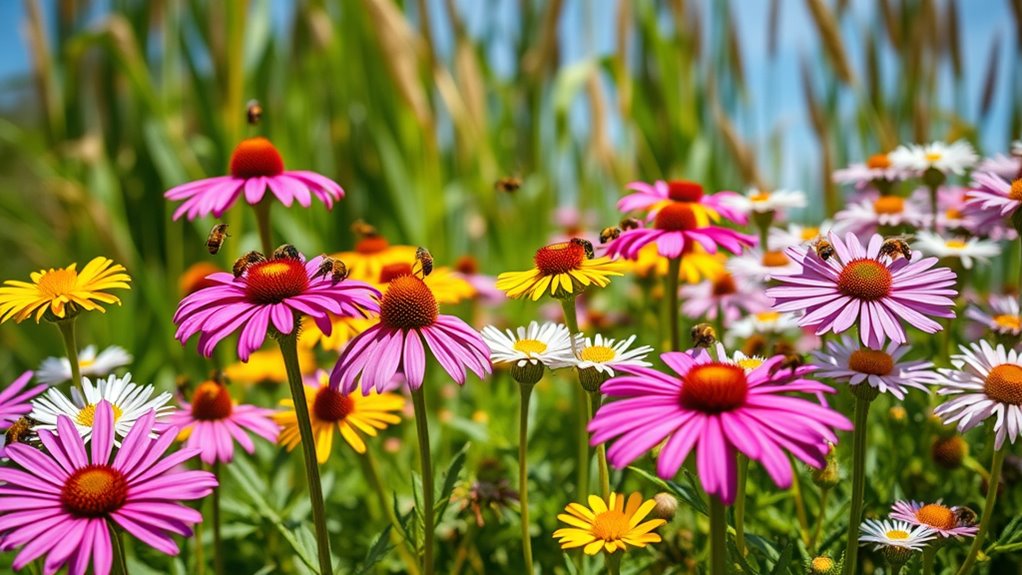
Native plants form the backbone of a healthy pollinator garden because they have evolved alongside local bees and other insects. This long-term relationship means native plants provide the specific nectar and pollen sources that bees need for ideal nutrition. They are also better adapted to local soil, climate, and pests, reducing maintenance and chemical use. By planting native species, you create a sustainable environment that attracts and supports a diverse range of bee species, from solitary to social types. Native plants also tend to bloom at times that match bees’ natural foraging cycles, encouraging healthy colonies. Incorporating these plants into your garden not only benefits bees but also enhances overall biodiversity, creating a resilient, vibrant ecosystem that thrives with minimal intervention. Understanding personal debt forgiveness bills can help gardeners and conservationists alike navigate financial resources for habitat projects.
Incorporating Blooming Periods for Continuous Food Sources

To keep pollinators fed throughout the season, you should aim for plants that bloom at different times. Stagger your planting schedule so flowers appear continuously, rather than all at once. This approach guarantees a steady food supply that supports pollinator health year-round. Incorporating a variety of blooming periods can also attract a diverse range of pollinators, enhancing biodiversity in your garden.
Diverse Bloom Times
Have you ever wondered how to keep pollinators consistently fed throughout the growing season? One effective way is planting a variety of flowers that bloom at different times. This ensures a steady food supply, preventing gaps when certain plants finish flowering. By selecting species that bloom early, mid, and late season, you create a continuous nectar and pollen source. This benefits not only bees but other pollinators too. Focus on diverse plant types and native species, which are more likely to thrive and attract local pollinators. Remember, a well-planned garden with staggered bloom times supports a resilient pollinator community and promotes biodiversity. Incorporating plants with different flowering schedules helps sustain a diverse pollinator habitat and keeps your garden lively and buzzing year-round.
Staggered Planting Schedule
Creating a staggered planting schedule guarantees your garden provides a continuous supply of nectar and pollen for pollinators throughout the growing season. To do this, select a variety of plants that bloom at different times—early spring, mid-summer, and late fall. By planting species with overlapping blooming periods, you ensure pollinators always have access to food sources. Mix perennials, shrubs, and annuals for diversity and extended flowering. Keep in mind that some plants may need specific conditions or spacing, so plan accordingly. Regularly replace or add new plants as seasons change to maintain coverage. This approach not only supports pollinator health but also enhances your garden’s beauty and resilience. A well-planned schedule keeps your garden lively and beneficial for pollinators year-round. Incorporating plant diversity into your garden design helps create a more resilient and sustainable habitat for pollinators.
Creating Habitats and Shelter for Pollinators
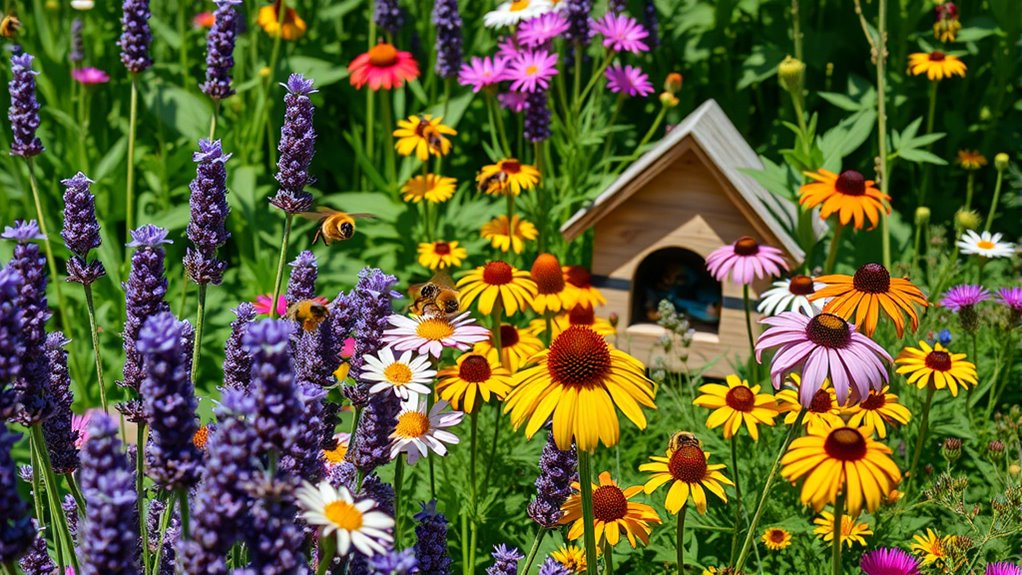
Providing suitable habitats and shelter is essential for supporting pollinators and encouraging healthy populations. Creating diverse spaces allows bees, butterflies, and other pollinators to rest, nest, and find refuge from predators. You can achieve this by leaving some areas undisturbed, adding woody debris, or planting native plants that offer shelter. Consider installing bee hotels or leaving patches of bare ground for ground-nesting species. Ensuring access to water sources, like shallow dishes or small ponds, also helps sustain pollinators during hot months. These habitats not only support pollinators but also enhance the overall biodiversity of your garden. Incorporating cost-effective options such as natural materials and simple landscape features makes it easier to create inviting environments for pollinators without straining your budget.
Avoiding Pesticides and Harmful Chemicals in Your Garden
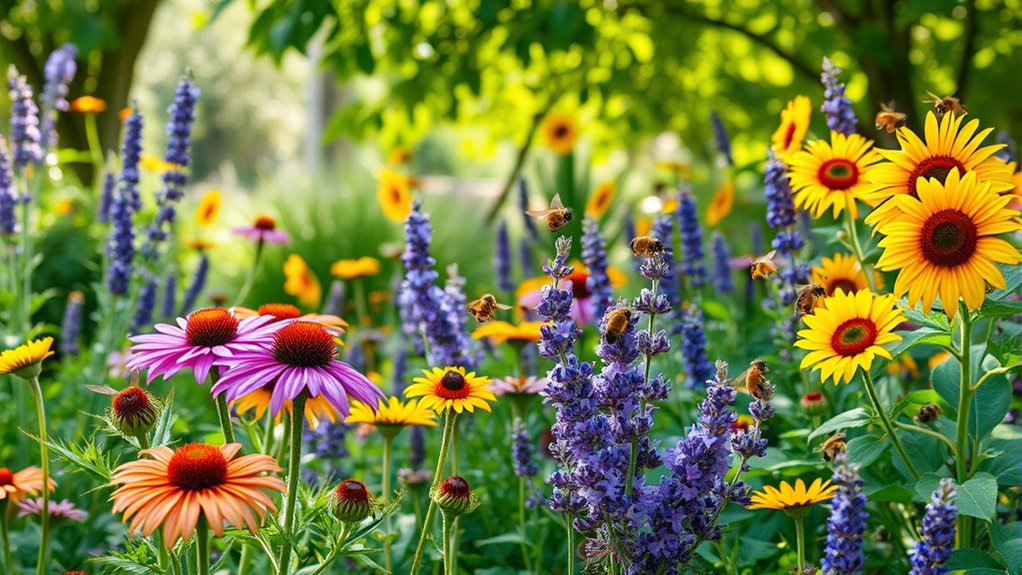
To protect pollinators and maintain a healthy garden, it’s essential to avoid using pesticides and harmful chemicals. These substances can poison bees, butterflies, and other beneficial insects, disrupting pollination and threatening biodiversity. Instead, opt for natural pest control methods like introducing beneficial insects, handpicking pests, or using organic solutions. Your choices matter—each chemical-free action supports pollinator health and preserves your garden’s vibrancy.
| Harmful Chemicals | Safe Alternatives |
|---|---|
| Synthetic pesticides | Companion planting |
| Herbicides | Organic neem oil |
| Fungicides | Biological controls |
| Chemical fertilizers | Composting and natural amendments |
| Synthetic weed killers | Manual removal |
Designing Landscapes to Attract a Variety of Pollinators

Designing landscapes that attract a variety of pollinators involves selecting diverse plant species that bloom at different times and offer nectar and pollen sources throughout the seasons. By choosing plants with a range of colors, shapes, and sizes, you create an inviting habitat for bees, butterflies, and other pollinators. Incorporate native plants, which are better adapted to your local environment and support local pollinator populations. Group similar plants together to make foraging easier and more efficient. Incorporate layered plantings—ground covers, shrubs, and flowering trees—to provide shelter and continuous food sources. This strategy boosts biodiversity and ensures pollinators have access to resources year-round.
- Choose native and flowering plants
- Plant in clusters for easier foraging
- Provide layered vegetation
- Bloom at different times of the year
Engaging Community and Educational Initiatives

Engaging the community and educational initiatives amplifies the impact of creating pollinator-friendly landscapes. When you involve neighbors, schools, and local organizations, you foster a shared sense of responsibility and enthusiasm. Educational programs can teach about native plants, pollinator habits, and the importance of biodiversity. Hosting workshops or planting days encourages hands-on participation, making conservation efforts more effective. To clarify roles and goals, consider this table:
| Initiative Type | Key Benefits |
|---|---|
| Community Workshops | Increase awareness, foster collaboration |
| School Programs | Instill conservation values early |
| Volunteer Planting Days | Build community spirit, expand habitats |
| Local Campaigns | Raise visibility, promote action |
| Educational Signage | Inform visitors, sustain engagement |
Monitoring and Maintaining a Healthy Pollinator Environment
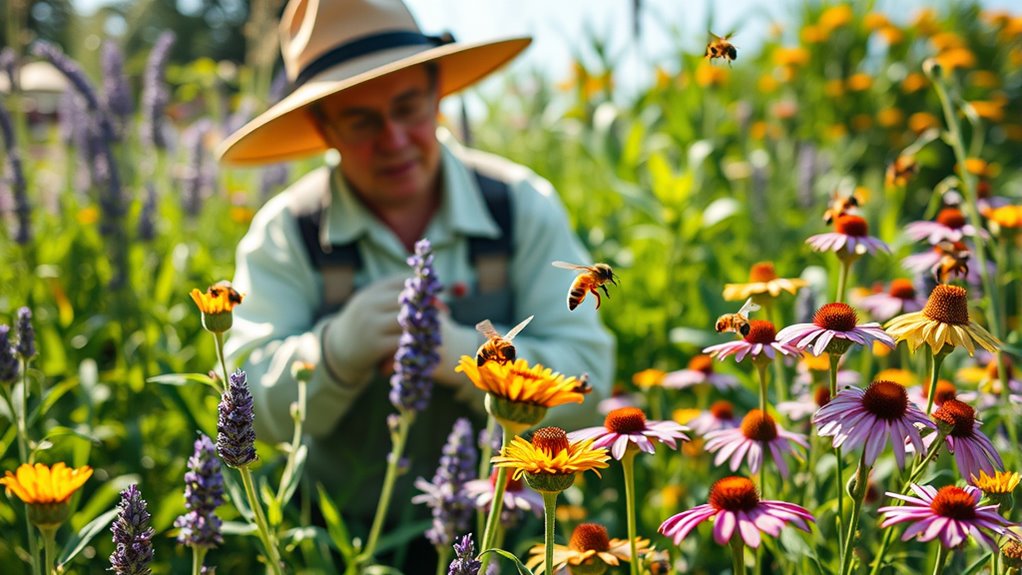
Maintaining a healthy pollinator environment requires regular monitoring and proactive management. You should observe pollinator activity to identify any declines or issues early. Keep track of flowering times and plant health to guarantee nectar and pollen sources remain abundant. Regularly inspect nests and hives for signs of pests or diseases. Taking swift action helps prevent problems from escalating. To stay on top of your pollinator habitat, consider these steps:
- Conduct periodic surveys of pollinator populations
- Remove invasive species that compete with native plants
- Adjust planting schedules to ensure continuous bloom
- Use organic methods to control pests and diseases
Frequently Asked Questions
How Can Urban Environments Be Made More Pollinator-Friendly?
You can make urban environments more pollinator-friendly by planting native flowers that provide nectar and pollen, creating green spaces like parks and rooftop gardens, and avoiding pesticides that harm bees. Installing bee hotels and leaving some areas undisturbed gives pollinators safe nesting sites. Educate others about the importance of pollinators, and advocate for policies that support urban biodiversity. Small actions collectively make a big difference for pollinator health.
What Are the Best Practices for Overwintering Pollinator Habitats?
Overwintering pollinator habitats is vital, as many bees, like bumblebees, rely on specific sites to survive winter. To do this effectively, you should leave dead stems and leaf litter undisturbed, providing natural shelter. You can also create designated overwintering areas with mulch or leaf piles. Make certain your habitat is in a sheltered, sunny spot, and avoid disturbing it during the cold months to give pollinators the best chance to thrive come spring.
How Do Invasive Species Affect Native Pollinator Populations?
Invasive species often outcompete native plants, reducing the food sources and habitat options for native pollinators. When invasive plants dominate, bees and other pollinators struggle to find the nectar and pollen they need, which can lead to declining populations. You can help by removing invasive species from your yard and planting native flowers that support local pollinators, ensuring they have the resources to thrive.
Can Growing Non-Native Plants Harm Local Bee Species?
You might not realize it, but growing non-native plants can harm local bee species. These plants sometimes outcompete native ones, reducing the food sources that bees rely on. Additionally, non-native species may not provide the necessary nectar or pollen quality, leading to nutritional deficiencies. By planting native species, you support local bees’ health, ensuring they thrive and maintain ecosystem balance. Your choices directly influence pollinator diversity and overall biodiversity.
What Are Effective Ways to Involve Children in Pollinator Conservation?
You can involve children in pollinator conservation by making it fun and educational. Take them on nature walks to observe bees and butterflies, and teach them about the plants that support these pollinators. Get them planting native flowers or creating mini habitats like bee hotels. Encourage curiosity by sharing stories about pollinators and their importance. Hands-on activities help kids develop a love for nature and a sense of responsibility to protect it.
Conclusion
By planting thoughtfully and avoiding harmful chemicals, you become a hero in the fight for pollinator survival. Your garden can be a sanctuary where bees and butterflies thrive, weaving a vibrant tapestry of biodiversity. Remember, every blooming flower and shelter you provide is a note in the symphony of nature’s balance. Together, we can turn our yards into essential oases—because when we nurture pollinators, we’re really nurturing our future.




